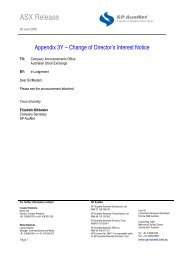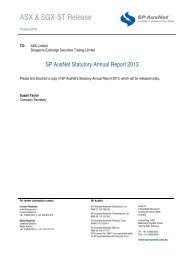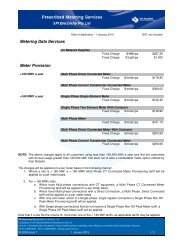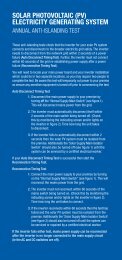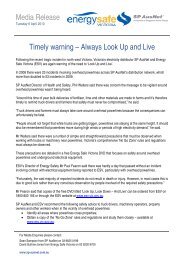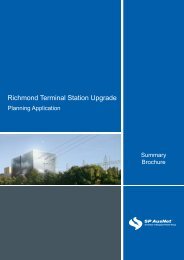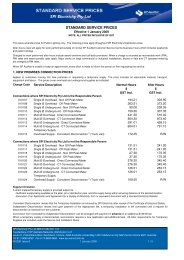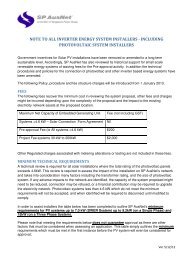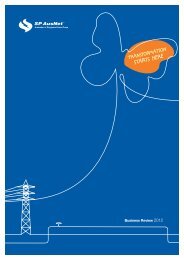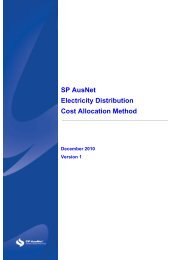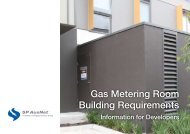AGILITY IN A CHANGING WORLD - SP AusNet
AGILITY IN A CHANGING WORLD - SP AusNet
AGILITY IN A CHANGING WORLD - SP AusNet
You also want an ePaper? Increase the reach of your titles
YUMPU automatically turns print PDFs into web optimized ePapers that Google loves.
STRENGTHEN TRANSFORM EXTEND MODERNISE<br />
ISSUE 6 SUMMER 2011/12<br />
ENSUR<strong>IN</strong>G REGULATION IS FIT FOR THE FUTURE<br />
Changes to our operating framework<br />
MANAG<strong>IN</strong>G THE LIVES OF OUR ASSETS<br />
Using international standards to manage our networks<br />
CUSTOMERS THE KEY TO DEMAND MANAGEMENT<br />
Empowered customers managing their energy needs<br />
<strong>AGILITY</strong> <strong>IN</strong> A<br />
CHANG<strong>IN</strong>G<br />
<strong>WORLD</strong>
2<br />
ENERGISE ISSUE 6<br />
EXTEND MODERNISE<br />
A message<br />
from Nino<br />
With the festive season approaching us, enjoy time<br />
out with family and friends. Remember that safety is<br />
important every single day – keep you and your loved<br />
ones safe over summer:<br />
• Keep hydrated on hot days – drinking a cup of water<br />
(about 200 mL) every 15 to 20 minutes.<br />
• Organise to catch public transport or assign<br />
a designated driver if planning to drink at<br />
festive celebrations.<br />
• Stay sun protected by wearing a wide brim hat,<br />
collared shirt and long pants, sunglasses and<br />
sunscreen. Rule of thumb: if the UV Index is 3 or<br />
higher, the radiation can damage your skin and eyes,<br />
so check the UV index, not the skies!<br />
• You may be more likely to experience stress over<br />
the summer season due to a busy schedule or<br />
additional expenses. Talk to family and friends, take<br />
time to relax and do something you enjoy if feeling<br />
stressed. If you feel you are struggling to cope, call<br />
our Employee Assistance Program on 1800 337 068.<br />
• Don’t let an accident or injury keep you from<br />
enjoying the festive season.<br />
Welcome to this sixth edition<br />
of ENERGISE, in which we aim<br />
to capture a number of the key<br />
developments for our industry<br />
and outline how <strong>SP</strong> <strong>AusNet</strong><br />
is responding.<br />
As highlighted in the article about<br />
regulation, much of the change<br />
we face is generated by the public<br />
policy and regulatory environment.<br />
As a highly regulated business,<br />
<strong>SP</strong> <strong>AusNet</strong> not only seeks to<br />
anticipate and respond to these<br />
changes, but also to share our<br />
experience and views on how<br />
policies and regulation can best<br />
meet the challenges that face<br />
our networks, customers and<br />
other stakeholders.<br />
Technology and innovation are<br />
other ways to shape change. As<br />
outlined in the article on demand<br />
management, we’re starting with<br />
our customers’ expectations of<br />
energy to help us find innovative<br />
technology solutions to manage<br />
our networks. This is a fastmoving<br />
area and many parts of<br />
the energy supply chain are<br />
involved, so we will leverage our<br />
strengths as a networks business<br />
to deliver on our core purpose to<br />
provide superior energy solutions<br />
to our customers.<br />
As we approach the end of the<br />
year, we reflect on some of our<br />
employees’ achievements with<br />
our annual Inspire Award winners.<br />
These are employees who have<br />
gone that extra mile, delivering<br />
outstanding results for our<br />
business. I would like to extend my<br />
congratulations to those winners,<br />
as well as recognise the 300 high<br />
quality nominations for this year.<br />
The efforts and commitments of<br />
all our people are central to our<br />
success – thank you.<br />
Our refreshed safety vision and<br />
strategy, missionZero, launched<br />
earlier this year, continues to be<br />
a key focus area. A number of<br />
key initiatives have been rolled<br />
out across the business aimed at<br />
driving our safety performance<br />
towards our target of zero injuries.<br />
On a final note, I would like to pay<br />
tribute to Carol Bull, a much-loved<br />
colleague and friend who passed<br />
away recently. Carol was an<br />
exceptional person who brought<br />
a mix of grace and good humour<br />
to her role. There are many<br />
people across the organisation<br />
and beyond who, like me, will<br />
feel a deep sense of loss from the<br />
realisation she will no longer be<br />
with us.<br />
On behalf of <strong>SP</strong> <strong>AusNet</strong>, I wish you<br />
a safe and happy holiday season.<br />
I hope you enjoy this edition<br />
of ENERGISE.<br />
Nino Ficca,<br />
Managing Director <strong>SP</strong> <strong>AusNet</strong>
ENERGISE is a quarterly publication of <strong>SP</strong> <strong>AusNet</strong>.<br />
ENERGISE is printed using environmentally friendly vegetable inks<br />
on 100% recycled paper.<br />
For more information, to suggest a story or to provide feedback,<br />
please email <strong>SP</strong> <strong>AusNet</strong>’s Corporate Relations team at<br />
public.relations@sp-ausnet.com.au<br />
TRANSFORM<br />
EXTEND<br />
MODERNISE<br />
STRENGTHEN<br />
Front Cover image:<br />
<strong>SP</strong> <strong>AusNet</strong>’s transmission network connecting<br />
into Latrobe Valley’s electricity generators<br />
taken by <strong>SP</strong> <strong>AusNet</strong> employee Jonathon Geddes.<br />
Printed on 100% recycled stock.<br />
In this issue<br />
Preparing for the bushfire season 4<br />
Ensuring Regulation is fit for the future 6<br />
Busting the myths of smart meters 9<br />
Supporting a renewable future 10<br />
My Safety Commitment 11<br />
How are we tracking 12<br />
A day in the life of… 14<br />
Modernising our fault response 15<br />
Managing the lives of our assets 17<br />
One inspirational evening 18<br />
Customers the key to demand management 22
4 ENERGISE ISSUE 6<br />
We’re preparing for<br />
bu sh fir es eason<br />
ARE YOU<br />
Darren Walker, <strong>SP</strong> <strong>AusNet</strong><br />
As your electricity distributor, <strong>SP</strong> <strong>AusNet</strong><br />
is responsible for undertaking an extensive<br />
bushfire mitigation program in preparation<br />
for the bushfire season each year.<br />
<strong>SP</strong> <strong>AusNet</strong> team members like Darren Walker,<br />
have inspected over 125,000 powerpoles and<br />
cleared and pruned more than 125,000 trees<br />
that were close to powerlines.<br />
We have also invested in excess of<br />
$58 million to make our network safer<br />
and even more reliable.<br />
Now it’s time for you to do your part. It’s your<br />
responsibility to check your private overhead<br />
electric powerline for any damage and to<br />
make sure trees and branches remain clear<br />
at all times.<br />
Preparing for<br />
the bushfire season<br />
An example of the current Bushfire Mitigation newspaper advertisement.<br />
With summer fast approaching, <strong>SP</strong> <strong>AusNet</strong><br />
has been busy preparing its networks for<br />
this year’s bushfire season.<br />
STRENGTHEN<br />
TRANSFORM<br />
EXTEND<br />
MODERNISE<br />
Each year, <strong>SP</strong> <strong>AusNet</strong> is required<br />
to submit a Bushfire Mitigation<br />
Plan to Energy Safe Victoria (ESV)<br />
before the end of June. This plan<br />
is then reviewed with the aim of<br />
being approved in time for the<br />
bushfire season, usually around<br />
the beginning of November.<br />
Alongside an extensive amount<br />
of vegetation management, asset<br />
inspections and maintenance,<br />
and technical enhancements to<br />
our network, we also commit to<br />
our annual bushfire mitigation<br />
public awareness campaign to<br />
help landowners understand their<br />
responsibilities in maintaining their<br />
private electrical assets.<br />
Engaging with our<br />
stakeholders<br />
In October, <strong>SP</strong> <strong>AusNet</strong> launched<br />
its annual public awareness<br />
campaign, which involves a mix<br />
of advertising, public relations and<br />
direct mail communication across<br />
our electricity distribution network<br />
in north and eastern Victoria.<br />
The advertisements, aired across<br />
regional TV, press and radio,<br />
highlight the need for residents<br />
with private overhead electric<br />
powerlines (POEL) to maintain<br />
and check tree and vegetation<br />
clearances and any other hazards<br />
that could affect the powerlines or<br />
have potential to ignite a fire.<br />
To further help facilitate strong<br />
communication with our<br />
communities, a copy of these<br />
materials has been sent to all local<br />
municipalities in north and eastern<br />
Victoria, as well as all Federal<br />
and State Members of Parliament<br />
representing areas within our<br />
electricity network.<br />
Our Regional Managers and<br />
their staff are doing their bit<br />
by providing expert advice at<br />
multiple emergency agency and<br />
fire planning meetings throughout<br />
the year.
ISSUE 6 ENERGISE 5<br />
Have you checked your<br />
private overhead electric line<br />
If you see any faults or hazards<br />
call 13 17 99.<br />
To find out more about<br />
private overhead<br />
electric powerlines and<br />
your responsibilities<br />
call <strong>SP</strong> <strong>AusNet</strong> on 1300 360 795<br />
or visit www.sp-ausnet.com.au<br />
Behind the scenes at the Bushfire Mitigation TV commercial filming.<br />
Getting ready<br />
Investing in vegetation management is essential to prevent<br />
supply outages and reduce bushfire risk, where our focus<br />
is to ensure a safe and reliable electricity supply to our<br />
customers.<br />
Prior to the bushfire season beginning in November, we have:<br />
• inspected more than 125,000 powerpoles<br />
• cleared or pruned more than 125,000 trees<br />
• invested more than $58 million<br />
… to make our networks even safer and more reliable.<br />
Maintaining proper<br />
vegetation levels<br />
<strong>SP</strong> <strong>AusNet</strong> continues to engage<br />
with communities on the need for<br />
proper vegetation management.<br />
This ensures tree clearing around<br />
powerlines is an essential part of<br />
the safe and reliable operation of<br />
our networks.<br />
There are approximately 14,000<br />
properties in <strong>SP</strong> <strong>AusNet</strong>’s<br />
electricity network with private<br />
overhead electric lines located on<br />
their property.<br />
These residents are required to<br />
keep private overhead electric<br />
lines clear of trees and vegetation<br />
that are deemed too close to<br />
powerlines, with an appropriately<br />
qualified contractor to prune<br />
vegetation where necessary.<br />
<strong>SP</strong> <strong>AusNet</strong> prepares a POEL<br />
brochure each year to provide<br />
useful information on how to<br />
safely maintain the line and assist<br />
in identifying potential hazards.<br />
For further information on<br />
responsibilities with private<br />
overhead electric lines,<br />
residents are encouraged to call<br />
<strong>SP</strong> <strong>AusNet</strong>’s customer service<br />
line on 1300 360 795 or visit<br />
www.sp-ausnet.com.au.<br />
Industry focus on bushfire<br />
safety<br />
At an industry level, <strong>SP</strong> <strong>AusNet</strong><br />
is working towards ensuring the<br />
safety of Victorian communities<br />
against the threat of bushfires.<br />
In mid-2010, the Victorian<br />
Bushfire Royal Commission<br />
identified seven recommendations<br />
specifically relevant to the<br />
electricity industry. Five of these<br />
were accepted in principle by the<br />
Government, with the remaining<br />
two recommendations (27 and 32)<br />
referred to the Powerline Bushfire<br />
Safety Taskforce.<br />
These two recommendations, the<br />
most significant for <strong>SP</strong> <strong>AusNet</strong>, are<br />
around changes to the operation<br />
of the electricity distribution<br />
networks, in particular protection<br />
and control device settings, for<br />
certain time periods on selected<br />
days of high bushfire risk.<br />
<strong>SP</strong> <strong>AusNet</strong> was part of the<br />
taskforce, established by the<br />
Victorian Government through ESV.<br />
The taskforce’s role was to<br />
investigate the full range of<br />
options available to reduce the<br />
risks of bushfires from electricity<br />
infrastructure within the next<br />
decade, and to quantify the<br />
benefits and cost, taking into<br />
account all measures already<br />
adopted by government.<br />
The taskforce presented its final<br />
report to ESV on 30 September<br />
2011, with the Victorian<br />
Government expected to release<br />
its response to the report before<br />
the end of this year.<br />
While the Government prepares<br />
its response, <strong>SP</strong> <strong>AusNet</strong> has<br />
proactively engaged with key<br />
stakeholders – Energy Safe<br />
Victoria and the Department of<br />
Primary Industries – on a plan<br />
to effectively communicate the<br />
expected network changes, which<br />
could include suppression of<br />
supply on high bushfire risk days<br />
and other impacts to customers.<br />
For our network, as part of our<br />
ongoing asset maintenance and<br />
replacement program, we are<br />
in the process of upgrading the<br />
capabilities of our protection and<br />
control devices to help manage<br />
bushfire risks.
6 ENERGISE ISSUE 6<br />
Regulatory stakeholder framework<br />
Ensuring Regulation<br />
is fit for the future<br />
<strong>SP</strong> <strong>AusNet</strong>’s transmission and distribution<br />
networks are underpinned by a range<br />
of economic, technical and safety<br />
REGULATIONS.<br />
STRENGTHEN<br />
TRANSFORM<br />
EXTEND<br />
MODERNISE<br />
Determined and implemented<br />
by Government bodies and<br />
regulators, regulations influence<br />
our operational and commercial<br />
frameworks.<br />
Our frameworks are designed<br />
to address a range of policy<br />
objectives, such as delivering safe<br />
and reliable energy.<br />
In addition, our frameworks must<br />
reflect and adapt to changes<br />
in the energy sector: increased<br />
energy demand from a growing<br />
population; changing consumer<br />
demand patterns; greater access<br />
to renewable energy; climate<br />
change and technological<br />
advancement.<br />
As a privately owned network, we<br />
must ensure investor certainty<br />
along with adequate returns for<br />
our securityholders. As such, any<br />
changes to the framework are of<br />
great importance to us and how<br />
we operate our networks. At the<br />
time of writing, there are several<br />
key regulatory and policy changes<br />
underway that will affect<br />
our business.<br />
Proposed changes by the AER<br />
At the end of September, our<br />
economic regulator, the Australian<br />
Energy Regulator (AER), submitted<br />
proposed changes to the National<br />
Electricity Law and National Gas<br />
Law to the Australian Energy<br />
Market Commission (AEMC).<br />
The AEMC is the body that advises<br />
the Commonwealth Government<br />
on the rules to balance supply and<br />
demand of both electricity and<br />
gas, to deliver energy efficiently<br />
to consumers.<br />
These laws are of key importance<br />
to <strong>SP</strong> <strong>AusNet</strong>, as they determine<br />
the elements of expenditure that<br />
we can recover for operating<br />
our networks.<br />
The AEMC is considering the<br />
AER’s proposed rule changes<br />
and, in response, has issued a<br />
consultation paper requesting<br />
submissions by the first week<br />
in December.<br />
If accepted by the AEMC, the AER’s<br />
rule changes would provide them<br />
with greater discretion in making
ISSUE 6 ENERGISE 7<br />
Gas mains renewal will be factored into the next GAAR.<br />
Monitoring our gas network<br />
pricing decisions. However, the<br />
AER is one stakeholder in the<br />
process and we do not support<br />
some of their reasoning.<br />
<strong>SP</strong> <strong>AusNet</strong> will play an active part<br />
in the AEMC process, highlighting<br />
the importance of ensuring<br />
reliable, safe supply of energy to<br />
our customers, as well as outlining<br />
the importance of investor<br />
certainty.<br />
Electricity<br />
Transmission<br />
Electricity<br />
Distribution<br />
Diversified regulatory reset periods<br />
2011 2012 2013 2014 2015 2016 2017<br />
Consumers are another key<br />
stakeholder group, represented<br />
by a range of consumer advocacy<br />
groups. The Energy Users<br />
Association of Australia (EUAA)<br />
representing industrial energy<br />
customers has also lodged its own<br />
proposed rule change with<br />
the AEMC.<br />
The process of rule change will<br />
take around 12 months, which<br />
means that <strong>SP</strong> <strong>AusNet</strong>’s impending<br />
gas and electricity transmission<br />
price resets would be covered<br />
under the existing rules, with<br />
<strong>SP</strong> <strong>AusNet</strong>’s electricity distribution<br />
first affected by any new rules<br />
in 2015.<br />
Gas Distribution<br />
Staggered reset periods<br />
reduces regulatory risk<br />
Gas Access Arrangement<br />
Review (GAAR)<br />
Every five years, we participate<br />
in price reviews for each of<br />
our networks with the AER, to<br />
get approval for recovery of<br />
investment which is required<br />
for the expenditure to meet<br />
performance requirements for the<br />
safe and reliable transportation<br />
of energy.<br />
At present, we are in the first<br />
year of the five-year Electricity<br />
Distribution Pricing Review<br />
(EDPR) and are working on our<br />
submission for the Gas Access<br />
Arrangement Review (GAAR),<br />
which will start January 1, 2013.<br />
key representatives from across<br />
the business are involved in<br />
developing the submissions to<br />
the AER, based on our projected<br />
Beginning of new<br />
reset period<br />
Diversified regulatory reset period table<br />
spends, planned programs and<br />
projects, customer growth and<br />
demand growth.<br />
We are on track to lodge our<br />
GAAR submission at the end of<br />
March 2012. The AER is expected<br />
to release its draft determination<br />
in August, which is open for<br />
independent responses, and its<br />
final determination at the end of<br />
next year.<br />
Continued next page...
8 ENERGISE ISSUE 6<br />
Ensuring Regulation is fit for the future (cont.)<br />
State and Territory<br />
Governments<br />
Ministerial Council on Energy<br />
Commonwealth<br />
Government<br />
• Some governments<br />
continue to own and<br />
operate parts of the<br />
system (not Vic)<br />
• Planning<br />
• Environmental policy<br />
• Investment facilitation<br />
• Innovation support<br />
• Community engagement<br />
• Resource allocation<br />
Australian<br />
Energy Market<br />
Commission<br />
Rule maker<br />
and adviser<br />
Australian<br />
Energy Market<br />
Operator<br />
System<br />
operator and<br />
planning for<br />
future needs<br />
Australian<br />
Energy<br />
Regulator<br />
Economic<br />
regulator*<br />
(including price<br />
determination)<br />
* part of ACCC<br />
• Climate change policies<br />
(eg. Carbon price,<br />
renewable energy targets)<br />
• Innovation support<br />
• Some environmental policy<br />
• Taxes<br />
Our Stationary Energy System<br />
Operating in a highly regulated industry requires active<br />
engagement with regulators, Governments and other<br />
stakeholders to ensure that framework changes are measured<br />
and strengthen incentives to how we deliver energy now and<br />
into the future.<br />
Introduction of carbon pricing<br />
The Federal Government’s climate<br />
change reform has taken a major<br />
step, with the Clean Energy<br />
legislation passing through the<br />
Senate in early November.<br />
This legislation aims to transition<br />
Australia to a clean energy<br />
economy through initiatives in<br />
four key areas – carbon pricing,<br />
renewable energy, energy<br />
efficiency and land management.<br />
Central to this is a two stage<br />
carbon price mechanism, starting<br />
at $23 per tonne from 1 July 2012<br />
for Australia’s 500 largest carbon<br />
emitters, before transitioning to a<br />
‘cap and trade’ emissions trading<br />
scheme in 2015.<br />
For the past three years,<br />
<strong>SP</strong> <strong>AusNet</strong> and other corporations<br />
meeting or exceeding thresholds<br />
for emissions of greenhouse<br />
gases, have been obliged to report<br />
emissions under the National<br />
Greenhouse and Energy Reporting<br />
(NGER) Act 2007, which have<br />
shown that <strong>SP</strong> <strong>AusNet</strong> emits<br />
greenhouse gas emissions from a<br />
range of activities. This reporting<br />
obligation will form the basis on<br />
which the carbon price will<br />
be applied.<br />
The direct impact of the carbon<br />
price on <strong>SP</strong> <strong>AusNet</strong> will be limited,<br />
as it will only apply to <strong>SP</strong> <strong>AusNet</strong>’s<br />
fugitive gas emissions.<br />
These emissions result from<br />
breakages and leaks in our<br />
ageing low pressure gas pipes.<br />
In addition, the use of sulphur<br />
hexafluoride as an insulator in<br />
our transmission and distribution<br />
networks will result in higher input<br />
costs, as part of an import and<br />
manufacture levy.<br />
As the legislation is relatively new,<br />
<strong>SP</strong> <strong>AusNet</strong> is analysing the price<br />
impacts but expect the carbon<br />
pricing mechanism will have a<br />
direct impact our business.<br />
On the positive side, the proposed<br />
investment by the government for<br />
the renewable energy sector is<br />
an opportunity for <strong>SP</strong> <strong>AusNet</strong> to<br />
increase our regulated asset base<br />
by connecting new energy sources<br />
to the electricity grid in Victoria.<br />
F-factor scheme<br />
The AER has made its draft<br />
determinations to set fire start<br />
targets for the Victorian electricity<br />
distribution businesses (DBs)<br />
under the Victorian Government’s<br />
f-factor scheme.<br />
The f-factor scheme is intended<br />
to provide incentives for Victorian<br />
DBs to reduce the risk of fire starts<br />
and to reduce the risk of loss or<br />
damage caused by fire starts.<br />
For the first four years (2012-15),<br />
DBs will be either rewarded or<br />
penalised at the incentive rate of<br />
$25,000 per fire for performing<br />
better or worse than their<br />
respective fire start targets.<br />
The Victorian Government<br />
published an f-factor scheme<br />
order 2011 in June that requires<br />
the AER to make a determination<br />
by 31 December 2011 setting out<br />
fire start targets for each DB for<br />
the 2012-15 period.
ISSUE 6 ENERGISE 9<br />
Smart meter installations underway<br />
Advancing metering infrastructure<br />
AS PART OF THE GOVERNMENT-MANDATED AMI<br />
PROGRAM, VICTORIAN HOMES AND SMALL BUS<strong>IN</strong>ESSES<br />
ARE HAV<strong>IN</strong>G THEIR CURRENT ELECTRICITY METER<br />
REPLACED WITH A SMART METER. THIS IS THE LARGEST<br />
<strong>IN</strong>VESTMENT <strong>IN</strong> VICTORIA’S ENERGY <strong>IN</strong>FRASTRUCTURE<br />
S<strong>IN</strong>CE THE <strong>IN</strong>TRODUCTION OF POLES AND WIRES.<br />
STRENGTHEN<br />
TRANSFORM<br />
EXTEND<br />
MODERNISE<br />
The Victorian Government, through<br />
the Department of Primary<br />
Industries, has mandated the<br />
state-wide smart meter roll out<br />
program, also referred to as the<br />
Advanced Metering Infrastructure<br />
(AMI). <strong>SP</strong> <strong>AusNet</strong>, along with<br />
Victoria’s four other electricity<br />
distribution businesses, is<br />
responsible for rolling out smart<br />
meters across Victoria.<br />
By the end of 2013 around 2.5<br />
million electricity meters will be<br />
in place and <strong>SP</strong> <strong>AusNet</strong> will have<br />
installed more than 720,000<br />
smart meters across northern and<br />
eastern Victoria. Since the roll<br />
out began in September 2009,<br />
Victoria’s electricity distribution<br />
businesses have collectively<br />
installed almost 900,000<br />
smart meters, with <strong>SP</strong> <strong>AusNet</strong><br />
successfully installing more than<br />
190,000 smart meters so far.<br />
WHY<br />
Replacing ageing metering<br />
infrastructure will enable more<br />
effective management of Victoria’s<br />
electricity network and ensure<br />
power distribution and supply<br />
is able to keep pace with future<br />
demand, particularly during<br />
peak periods.<br />
Smart meters will also provide the<br />
foundation for Victoria’s electricity<br />
consumers to better understand<br />
and manage their electricity<br />
usage and costs and will provide<br />
a platform for electricity retailers<br />
to offer their customers a suite of<br />
new tariffs and offers, resulting in<br />
increased choice.<br />
COSTS<br />
The costs associated with the roll<br />
out of smart meters and advanced<br />
metering infrastructure are being<br />
recovered over time via the<br />
metering charge which appears<br />
on your electricity bill. A metering<br />
charge has always formed part<br />
of your electricity bill and any<br />
charges are approved by the<br />
Australian Energy Regulator.<br />
Having a smart meter installed<br />
does not change the electricity<br />
tariff or unit price you pay for the<br />
power you consume. If you have<br />
questions about your electricity<br />
account, you need to contact your<br />
electricity retailer (the business<br />
who sends your electricity bills).<br />
SAFETY<br />
Electrical safety is a matter<br />
of utmost importance to the<br />
industry and to the community,<br />
and is fundamental to everything<br />
we do. Earlier this year, Energy<br />
Safe Victoria completed a<br />
comprehensive safety review<br />
that concluded that smart meters<br />
are being installed safely and by<br />
qualified and trained people.<br />
All <strong>SP</strong> <strong>AusNet</strong>’s meter installers<br />
are A-Grade electricians or<br />
lineworkers, who also complete<br />
a Government-accredited AMI<br />
training course before they are<br />
authorised to install meters on<br />
our behalf.<br />
Since 2009, smart meter installers<br />
have uncovered thousands of<br />
faults in electrical wiring and other<br />
defects which, in most cases,<br />
has been the first indication for<br />
consumers that defective wiring or<br />
other issues need to be repaired.<br />
Radio frequency levels from your<br />
smart meter are lower than those<br />
produced by common household<br />
appliances including your<br />
mobile phone, baby monitor and<br />
microwave oven.<br />
GOVERNMENT REVIEW<br />
The current Victorian Government<br />
has been undertaking a review<br />
of the AMI program. At the time<br />
of publication, outcomes had not<br />
been announced but are expected<br />
by the end of 2011. In the<br />
meantime, we continue the rollout,<br />
as mandated by the Victorian<br />
Government.
10 ENERGISE ISSUE 6<br />
Construction crews ‘bench’ the Macarthur site<br />
Supporting a renewable future<br />
<strong>SP</strong> AUSNET HAS BEEN WORk<strong>IN</strong>G ON MAJOR<br />
PROJECTS TO CONNECT W<strong>IN</strong>D, WATER AND<br />
GAS-GENERATED ELECTRICITy TO THE GRID.<br />
STRENGTHEN<br />
TRANSFORM<br />
MODERNISE<br />
EXTEND<br />
Two of these projects in western<br />
Victoria, AGL’s wind farm at<br />
Macarthur and Origin Energy’s<br />
gas-fired power station near<br />
Mortlake, are on track to supply<br />
electricity to the network in the<br />
next 12 months.<br />
<strong>SP</strong> <strong>AusNet</strong> Energy Solutions<br />
Manager, Con Sarantopoulos,<br />
provides an overview on how<br />
these projects will improve supply<br />
reliability and cater for increased<br />
consumer demand.<br />
“<strong>SP</strong> <strong>AusNet</strong> is helping facilitate<br />
the construction and connection<br />
of new sources of energy, some<br />
renewable, to the electricity grid.<br />
These projects will help strengthen<br />
our energy network to deliver<br />
secure and sustainable energy<br />
supply to meet the future needs<br />
for Victorians,” he said.<br />
Macarthur Wind Farm<br />
<strong>SP</strong> <strong>AusNet</strong> was awarded the<br />
tender to build the terminal station<br />
at AGL’s 420 Megawatt (MW) wind<br />
farm, the largest in the Southern<br />
Hemisphere.<br />
The Macarthur wind farm will have<br />
140 turbines that will generate<br />
enough energy to power the<br />
equivalent of 220,000 average<br />
Victorian households for a year<br />
and save 1.7 million tones of<br />
greenhouse gas emissions.<br />
“We’ve recently started<br />
construction of the terminal<br />
station, in particular, benching the<br />
site before we lay the foundations<br />
at the Macarthur wind farm,”<br />
Mr Sarantopoulos said.<br />
“The wind farm is expected to<br />
supply around 420 MW of clean,<br />
green wind energy into the<br />
network via the 500kV Moorabool<br />
- Heywood transmission line.<br />
“Once we complete the terminal<br />
station, the project will start<br />
feeding electricity into the grid<br />
at the end of 2012, with all 140<br />
turbines to be built by early 2013,”<br />
he said.<br />
Mortlake Gas-fired Power<br />
Station<br />
<strong>SP</strong> <strong>AusNet</strong> is also assisting Origin<br />
Energy to commission its 550<br />
MW gas-fired power station at<br />
the Mortlake terminal station that<br />
is operated and maintained by<br />
<strong>SP</strong> <strong>AusNet</strong>.<br />
“At Mortlake, we’ve consulted<br />
on the design and construction<br />
of the terminal station and built<br />
the line deviation assets that will<br />
feed the electricity generated from<br />
the two 225MW gas turbines;<br />
also to the Moorabool - Heywood<br />
transmission line,”<br />
Mr Sarantopoulos said.<br />
In addition to these two milestone<br />
projects, <strong>SP</strong> <strong>AusNet</strong> has also<br />
connected six embedded<br />
generators to its distribution<br />
network including Melbourne<br />
Water’s hydro plants now<br />
operating at Silvan, Sugarloaf,<br />
Olinda and at Upper yarra Dam,<br />
and Land Management System’s<br />
gas fired generators at Wollert and<br />
Hallam.
ISSUE 6 ENERGISE 11<br />
Paul Lane<br />
My safety commitment: Paul Lane<br />
ENERGISE RECENTLy CAUGHT UP WITH NORTH REGION MANAGER PAUL LANE TO DISCUSS<br />
THE IMPORTANCE OF BE<strong>IN</strong>G A SAFETy LEADER.<br />
energise<br />
What is your commitment<br />
to safety<br />
Safety must start with you and<br />
then follow with challenging those<br />
around you to also make safe<br />
choices. With that in mind I have<br />
five commitments to my personal<br />
safety:<br />
1. I am committed to always<br />
driving safely - I drive over<br />
45,000 km each year;<br />
2. I always try to understand my<br />
immediate environment to avoid<br />
putting myself in a dangerous<br />
situation;<br />
3. I ensure I have the same<br />
dedication to working safely<br />
when I’m at home;<br />
4. I exercise regularly - I love<br />
bike riding and bushwalking;<br />
and finally<br />
5. I book in for annual health<br />
checks with my doctor.<br />
energise<br />
As a leader within <strong>SP</strong> <strong>AusNet</strong>,<br />
how do you ensure you’re also<br />
a safety leader<br />
Real safety leadership comes from<br />
each individual. If we value our<br />
own safety and those around us<br />
then we’ll always make<br />
safe choices.<br />
It’s also about knowing your<br />
limitations and stopping or<br />
asking for help when you need<br />
to. I encourage discussion about<br />
the important things in life and<br />
making conscious safety choices<br />
to protect those things.<br />
My role as North Region Manager<br />
is also about supporting and<br />
urging team members to re-think<br />
how we go about our tasks and<br />
how we can further improve<br />
our safety.<br />
energise<br />
How do you promote<br />
the importance of safety<br />
New or old, senior or junior, it’s<br />
about encouraging the right<br />
mindset and backing that up<br />
with individual behaviours that<br />
put safety first. It’s often the<br />
common things we do that pose<br />
the greatest risk, such as driving<br />
vehicles, lifting, moving around<br />
our worksites and avoiding trips<br />
and falls.<br />
It’s vital for all team members to<br />
speak up and challenge each other<br />
when they see something not<br />
quite right. No one comes to work<br />
to hurt themselves but we need to<br />
be talking, checking and assisting<br />
each other to avoid that one lapse<br />
that could end in an injury.<br />
energise<br />
What does safety mean in<br />
the North region<br />
The North team has a really<br />
positive and proactive approach to<br />
working safely - our safety culture<br />
and experience is a strong one.<br />
Our Wodonga team is approaching<br />
seven years without a lost time<br />
injury. This fantastic achievement<br />
demonstrates that it is possible<br />
to work long periods without<br />
injury. One of our aims is to tap<br />
into teams and individuals who’ve<br />
worked safely for long periods to<br />
educate and inspire other teams to<br />
achieve similar results.
12 ENERGISE ISSUE 6<br />
ISSUE 6 ENERGISE 13<br />
Tracking our performance<br />
scorecard: FY 2011/12 – NOVEMBER<br />
S<strong>IN</strong>CE LAUNCH<strong>IN</strong>G OUR GROWTH STEM STRATEGY <strong>IN</strong> 2010, <strong>SP</strong> AUSNET HAS ALIGNED HOW WE MEASURE<br />
OUR GOALS AND COMMUNICATE PROGRESS TO EMPLOYEES. THE DIAGRAM BELOW TRACKS ALL<br />
CORPORATE TARGETS AND CLEARLY SHOWS HOW THEY RELATE TO OUR STRATEGY OF STRENGTHEN<strong>IN</strong>G,<br />
TRANSFORM<strong>IN</strong>G, EXTEND<strong>IN</strong>G AND MODERNIS<strong>IN</strong>G OUR BUS<strong>IN</strong>ESS. EMPLOYEES ARE ENCOURAGED TO<br />
LOOK OUT FOR THESE POSTERS ON NOTICEBOARDS TO KEEP TRACK OF THE COMPANY’S PROGRESS<br />
THROUGHOUT THE YEAR.<br />
STRENGTHEN<br />
TRANSFORM<br />
EXTEND<br />
MODERNISE<br />
Category Performance Versus Target YTD Status STEM<br />
Key Performance Indicators<br />
Year to date<br />
Actual<br />
Year to date<br />
Target<br />
Safety and Environment Recordable Injury Frequency Rate 11.0 7.7<br />
Reporting<br />
Period<br />
12 months<br />
rolling average<br />
Number of Network Incidents with Potential Fire Start 4,503 4,845 YTD Monthly<br />
Financial and Growth EBITDA ($M) Unfavourable YTD Monthly<br />
Return on Equity (%) Unfavourable YTD Monthly<br />
Credit Metrics A Range A Range Monthly<br />
Select Solutions External EBITDA ($M) 15.4 14.6 YTD Monthly<br />
Customer Service Regulated Customer Satisfaction (%) 85 87 Monthly<br />
Select Solutions Client Satisfaction Index (%) 79 80 Monthly<br />
Network Performance Electricity Unplanned System Average Incident Duration Index (USAIDI) (CY 11 mins) 136.6 147.6<br />
Electricity Transmission AER Performance Service Target Performance<br />
Incentive Scheme (STPIS) (CY11%)<br />
71.3 40.5<br />
Gas Unplanned System Average Interruption Duration Index (USAIDI) (CY 11 mins) 0.99 0.89<br />
Calendar<br />
YTD Monthly<br />
Calendar<br />
YTD Monthly<br />
Calendar<br />
YTD Monthly<br />
Performance Efficiency Total Controllable Operational Costs per Budgeted FTE ($’000) Unfavourable YTD Monthly<br />
Capital efficiency of completing works program (%)<br />
Result calculated<br />
March 2012<br />
Result calculated<br />
March 2012<br />
ICT Application Uptime Tier 1 (critical) (%) 100.0 98.0 YTD Monthly<br />
ICT Application Uptime Tier 2 (BAU) (%) 100.0 95.0 YTD Monthly<br />
People Voluntary Turnover (%) 3.7 4.0 Monthly<br />
Yearly<br />
Status SEP OCT NOV<br />
On or beating target<br />
Below target but expected to be favourable<br />
at year end<br />
Below target and risk of being unfavourable<br />
at year end
14<br />
ENERGISE ISSUE 6<br />
A DAY <strong>IN</strong> THE LIFE:<br />
Terry Jong<br />
ENERGISE <strong>SP</strong>ENT THE DAy <strong>IN</strong> THE ‘SHOES’ OF<br />
TERRy JONG, THE TEAM LEADER – PRIMARy,<br />
FROM <strong>SP</strong> AUSNET’S STATIONS DEVELOPMENT<br />
TEAM, TO F<strong>IN</strong>D OUT HOW HIS TECHNICAL<br />
DESIGN ROLE HELPS MEET THE STATE’S<br />
ELECTRICITy NEEDS.<br />
As the Team Leader – Primary,<br />
Terry is responsible for a team of<br />
six engineers who manage the<br />
design of electricity transmission<br />
developments and upgrades. At<br />
the moment, some of the projects<br />
that Terry and his team are<br />
working on include design options<br />
for a potential rebuild of the West<br />
Melbourne Terminal Station, being<br />
involved in the construction stage<br />
of the East Rowville Terminal<br />
Station transformer installation<br />
to ensure the original design is<br />
carried out and design of a new<br />
500 kV terminal station in Tarrone<br />
for the connection of a new<br />
wind farm.<br />
Terry’s role can change from day<br />
to day, but here’s what a typical<br />
day looks like:<br />
Network Strategy Development’s Terry Jong<br />
8:30 AM<br />
Terry starts the day by checking<br />
emails and reviewing all projects<br />
in the Project Execution Tracking<br />
(PET) database – checking what’s<br />
at stage 2 (broad scoping of the<br />
project) and stage 10 (specific<br />
detailed design for the project).<br />
9:30 AM<br />
Terry meets with Beca,<br />
<strong>SP</strong> <strong>AusNet</strong>’s preferred supplier of<br />
engineering services to <strong>SP</strong> <strong>AusNet</strong>,<br />
to discuss current design projects,<br />
particularly in relation to the timing<br />
of delivery and any foreseeable<br />
issues.<br />
10:00 aM<br />
Discussion with colleagues on<br />
the valuation of a tender for the<br />
Bendigo Terminal Station project<br />
(where two new transformers are<br />
being installed). Terry discusses<br />
which contractor should be<br />
awarded the design service<br />
contract based on price, quality,<br />
experience, personal and previous<br />
performances and exclusions.<br />
11:00 AM<br />
Terry meets with a new team<br />
member to talk them through<br />
<strong>SP</strong> <strong>AusNet</strong>’s personal development<br />
program and Annual Incentive<br />
Plan.<br />
11:30 AM<br />
Time to check those emails again,<br />
which just keep piling in. Terry<br />
responds to technical, process and<br />
financial questions, keeps an eye<br />
on how projects are progressing<br />
and provides guidance to his team<br />
on their projects.<br />
1:00 PM<br />
After a quick lunch, Terry meets<br />
with the Customer and Energy<br />
Operations Team and Project<br />
Development Team, as two key<br />
stakeholders. This was the first<br />
meeting of these two teams,<br />
where the group discussed the<br />
structure of both teams, how they<br />
can work better together, current<br />
issues and future projects.<br />
2:00 PM<br />
Terry spends some time catching<br />
up with each of his team members<br />
individually, to see how their<br />
projects are progressing and talk<br />
through any issues they might be<br />
facing. Terry also goes through<br />
his emails again and finalises a<br />
communication training session<br />
that he’s organising for his team.<br />
3:30 PM<br />
In the afternoon, Terry works on<br />
the West Melbourne Terminal<br />
Station redevelopment. The project<br />
sponsor has requested additional<br />
information to be included in the<br />
estimate and options report. Terry<br />
does some additional work to<br />
further investigate project costs<br />
and emails the extra detail to<br />
the project sponsor.<br />
5:30 PM<br />
After a productive day and good<br />
progress made on a number of<br />
projects, Terry calls it a day and<br />
heads home.
ISSUE 6 ENERGISE 15<br />
drawn from several disparate<br />
systems,” he said.<br />
Greg continued, saying the<br />
DOMS will play a vital role in<br />
providing our Customer Energy<br />
and Operations Team and Field<br />
Services teams with more<br />
accurate, real-time customer<br />
status and numbers off supply<br />
during any outages.<br />
“With better data available in<br />
real-time, our Network Controllers<br />
can make more rapid decisions on<br />
switching, enabling them, through<br />
our smart networks, to restore<br />
supply to more customers faster,”<br />
he said.<br />
“The data also enables controllers<br />
and Field Services employees<br />
to more effectively direct fault<br />
response crews to areas that have<br />
the most need,” Greg said.<br />
Modernising<br />
our fault response<br />
<strong>SP</strong> AUSNET IS ON AN ExCIT<strong>IN</strong>G JOURNEy TOWARDS SMARTER, SELF-HEAL<strong>IN</strong>G<br />
NETWORkS THAT COMMUNICATE MORE DATA THAN EVER BEFORE ON<br />
THE STATE OF OUR ASSETS AND RELIABILITy.<br />
One of the major building blocks<br />
for our journey is the network<br />
intelligence to be realised through<br />
the Network Management<br />
Automation (NMA) Program,<br />
specifically the upgrade to a<br />
new integrated Distribution<br />
Management System (DMS) and<br />
Outage Management System<br />
(OMS), the two systems together<br />
known as “DOMS”.<br />
NMA is also delivering a new<br />
improved Graphical Interface<br />
System (GIS) that is key in<br />
supporting critical business<br />
STRENGTHEN<br />
TRANSFORM<br />
EXTEND<br />
The DOMS will assist Network Controllers when making decisions on switching.<br />
operations and many of the<br />
leveraging opportunities for<br />
DOMS and the Advanced Metering<br />
Infrastructure program in<br />
the future.<br />
The delivery of a single smarter,<br />
more accurate, real-time system<br />
to manage distribution network<br />
and outage information is part of<br />
<strong>SP</strong> <strong>AusNet</strong>’s key strategic focus to<br />
modernise our energy networks,<br />
ensuring that we continue to<br />
provide superior energy solutions<br />
to our customers.<br />
MODERNISE<br />
Managing data during<br />
outages<br />
The move to a smarter network<br />
is key to providing more reliable<br />
energy to our customers and<br />
reducing USAIDI, which is the<br />
average number of unplanned<br />
minutes off supply per customer<br />
per year. By upgrading our<br />
technology, <strong>SP</strong> <strong>AusNet</strong> is better<br />
positioned to manage and<br />
minimise any customer outages.<br />
NMA Business Project Manager<br />
Greg Snibson said the project<br />
offered many benefits by<br />
upgrading our tool sets from what<br />
can be manual and difficult to use<br />
during storms to a much more<br />
state of the art system.<br />
“The DOMS will provide the<br />
business with more real-time<br />
up to date information about our<br />
networks, something currently<br />
The new systems will also feature<br />
enhanced reporting tools allowing<br />
people around the business<br />
to draw on more accurate<br />
information and support their<br />
planning or project decisions.<br />
Results through collaboration<br />
In a unique move, the team<br />
responsible for bringing these two<br />
systems to <strong>SP</strong> <strong>AusNet</strong> formed an<br />
alliance with a West Australian<br />
utility, Western Power Corporation<br />
(WPC), to leverage their experience<br />
with the product and realise the<br />
many advanced features available.<br />
The team are now surging ahead<br />
under the leadership of NMA<br />
Executive Sponsor John Azaris,<br />
who said the benefits of the<br />
system are expected to begin<br />
being realised in the next<br />
financial year.<br />
“The DMS is scheduled to be<br />
implemented in June 2012, with<br />
the OMS to follow in October<br />
2012,” he said.<br />
“Benefits achieved as a direct<br />
result of the systems will help us<br />
achieve our five-year objective<br />
of reducing the time customers<br />
are off supply through intelligent<br />
network applications.”<br />
“This project is a great example<br />
of the company’s strategic vision<br />
of modernising our businesses<br />
systems and processes,”<br />
John said.
16 ENERGISE ISSUE 6<br />
Managing the lives<br />
of our assets<br />
As the owner of three of Victoria’s largest energy networks, it’s <strong>SP</strong> <strong>AusNet</strong>’s<br />
responsibility to manage their lifecycles from end to end, delivering a high quality<br />
service to our customers.<br />
STRENGTHEN<br />
TRANSFORM<br />
EXTEND<br />
MODERNISE<br />
Rather than looking at individual<br />
power poles, gas pipes or<br />
transmission towers, we need to<br />
observe our energy networks and<br />
their overall asset management<br />
systems to identify what’s working<br />
and what needs to improve.<br />
Assessing our assets’<br />
abilities<br />
To aid us in managing our assets’<br />
lifecycles, <strong>SP</strong> <strong>AusNet</strong> has become<br />
the first Australian infrastructure<br />
business to achieve PAS 55 (2008)<br />
accreditation for our electricity<br />
transmission, gas distribution and<br />
electricity distribution networks.<br />
When <strong>SP</strong> <strong>AusNet</strong> sets its corporate<br />
direction each year – through<br />
business planning, risk plans,<br />
financial objectives and peoplerelated<br />
strategies – it’s important<br />
to understand the link between<br />
these strategies and our<br />
day-to-day activities. This can<br />
be achieved by using the PAS 55<br />
(2008) Standard.<br />
Networks Strategy and<br />
Development’s Business<br />
Improvement Manager, John<br />
Allen is responsible for the project<br />
management of various aspects<br />
of PAS 55 accreditation and<br />
improvement activities.<br />
“PAS 55 is an international<br />
reference used to rate the optimal<br />
management of physical assets.<br />
It provides our business with<br />
standard definitions of good<br />
practice in the whole-of-life<br />
management of assets,”<br />
John said.<br />
By developing an in-depth<br />
knowledge of the PAS 55<br />
requirements, John understands<br />
the strength that adhering to the<br />
standard brings our business.
ISSUE 6 ENERGISE 17<br />
By implementing the PAS 55 standards into our<br />
business, we can:<br />
PLAN – establish the necessary asset management<br />
strategies, objectives and plans that will deliver<br />
against our asset management policy and corporate<br />
business plan.<br />
DO – establish enablers for implementing asset<br />
management requirements, such as information<br />
systems, legal requirements, training and<br />
competencies, communication, risk, contingency<br />
planning and managing change.<br />
CHECK – monitor and measure the results against<br />
the asset management policy, strategy, plans and<br />
statutory requirements, record and report the results.<br />
ACT – review results and take actions to ensure<br />
that the asset management objectives and our asset<br />
management system continually improve.<br />
Taking the steps towards<br />
accreditation<br />
As John explains, firming up<br />
<strong>SP</strong> <strong>AusNet</strong>’s asset management<br />
approach began five years ago,<br />
when a risk management review<br />
highlighted the need for a stronger<br />
method of managing our<br />
energy networks.<br />
“As part of the regulated Price<br />
Review for <strong>SP</strong> <strong>AusNet</strong>’s electricity<br />
transmission network in 2007,<br />
we decided to investigate the<br />
use of BSI PAS 55 (2004) as<br />
an improvement tool, following<br />
discussions we had with the UK’s<br />
National Grid Company. The next<br />
step was undertaking a selfassessment<br />
project using the<br />
standard,” John said.<br />
Following this, our transmission<br />
network was accredited in 2008<br />
to the PAS 55 (2004) standard – a<br />
substantial change in approach<br />
where for the first time our<br />
focus was on the whole-of-life<br />
management of the company<br />
assets delivering efficiency and<br />
continuous improvement.<br />
“This systematic review provided<br />
a structured and optimised<br />
approach for identifying gaps<br />
in how we managed our assets<br />
and the improvement activities<br />
required,” John continued.<br />
In 2010, <strong>SP</strong> <strong>AusNet</strong> embarked on<br />
the next step by using the BSI PAS<br />
55 (2008) to identify improvement<br />
activities in our electricity<br />
distribution and gas distribution<br />
networks, with accreditation<br />
of both networks subsequently<br />
achieved in March 2011.<br />
Paving the way with PAS<br />
As overseen by John, the PAS 55<br />
Management System structure has<br />
24 clauses to rate performance,<br />
helping <strong>SP</strong> <strong>AusNet</strong> identify any<br />
gaps in our asset management<br />
approach.<br />
“The gap analysis helps to define<br />
which activities are necessary<br />
to further strengthen the<br />
performance of our<br />
three networks.<br />
“Some significant improvement<br />
areas identified included<br />
establishing an Asset Management<br />
Committee to maintain the<br />
overarching management of<br />
our ongoing asset activities<br />
and undertaking a more robust<br />
approach to the calibration of tools<br />
and equipment,” John said.<br />
The improvement process is<br />
almost continuous over the entire<br />
three-year accreditation cycle.<br />
Re-accreditation audits are<br />
due every three years, with our<br />
electricity transmission network<br />
achieving this in September<br />
2011, and our electricity and gas<br />
distribution networks due for reaccreditation<br />
in 2014.<br />
The accreditation stages include<br />
self-assessment, improvement<br />
plans, accreditation reviews and<br />
reports, more improvement plans<br />
and surveillance audits, then it’s<br />
back to the start to begin again for<br />
the next cycle.<br />
In between Accreditation Reviews<br />
and Surveillance Audits, the Asset<br />
Management Committee monitors<br />
the progress of improvement<br />
activities and prepares for reviews.<br />
Taking our company through<br />
the accreditation process is a<br />
huge undertaking, with a large<br />
number of employees across the<br />
majority of our divisions gaining an<br />
improved understanding of where<br />
they fit into the lifecycle activity by<br />
playing a role in self-assessments<br />
and reviews.<br />
Thanks to the benefits that PAS<br />
55 accreditation provides us,<br />
our commitment to the process<br />
remains strong.<br />
By aligning our networks to<br />
a global standard, <strong>SP</strong> <strong>AusNet</strong><br />
will keep identifying those<br />
improvements to help both<br />
maintain and strategically manage<br />
how we operate our assets’<br />
lifecycles from end-to-end.
18 ENERGISE ISSUE 6<br />
Our Inspire Award winners with Managing Director Nino Ficca (centre).<br />
One inspirational evening<br />
The success of <strong>SP</strong> <strong>AusNet</strong> relies on dedicated employees who go above and beyond their<br />
day-to-day role to achieve excellent results for the company.<br />
Now in its FOURTH year, the Inspire AWARDS are a PLATFORM to recognise and REWARD<br />
the outstanding efforts and achievements of <strong>SP</strong> <strong>AusNet</strong> employees.<br />
Inspire verb, -spired, -spiring.<br />
To inspire is to animate, spur on or encourage<br />
others, to fill them with revolutionary ideas,<br />
to affect them with a superior influence and to<br />
communicate inspiration to others.<br />
This year more than 300 nominations were<br />
received for the 2011 Inspire Awards.<br />
Congratulations to all nominees. A nomination is<br />
an honourable recognition of the hard work and<br />
commitment you have all made to <strong>SP</strong> <strong>AusNet</strong>, and<br />
something that should be celebrated.<br />
Nominations are now being taken for the 2012<br />
Inspire Awards.<br />
STRENGTHEN<br />
TRANSFORM<br />
MODERNISE<br />
EXTEND<br />
Nino
ISSUE 6 ENERGISE 19<br />
Community AWARD<br />
– presented to an employee who commits part of their time to make a real difference in<br />
the community.<br />
Adam Carrick<br />
Adam is described as a tremendous ambassador for <strong>SP</strong> <strong>AusNet</strong>, bringing valuable insight back in to the business<br />
from the communities in which it operates. As a driving force in the East Sustainability Working Group - a group<br />
of employees that dedicates time to making positive improvements to its community and work areas - he often<br />
assists local communities achieve their goals through sponsorship or ‘in-kind’ works.<br />
Last year, Adam was elected to the Community Sponsorship and Donations Fund as an employee representative.<br />
During the group’s first year, he has made many positive contributions, including assisting the Yarram Lions Club<br />
in its successful application for sponsorship of a food trailer, to be used within the community during<br />
major events.<br />
Adam is described as someone who understands that a little goes a long way in some communities and was<br />
recently involved in donating some old structures that were rusting in a yard to a community group who have put<br />
them to good use.<br />
Excellence AWARD<br />
– presented to an employee who consistently produces work of outstanding quality, which meets and<br />
exceeds the needs of the task or project outline, while outperforming benchmarks and contributing in<br />
an exceptional way to the business.<br />
Peter Kilevics<br />
Peter has been awarded for his exceptional design work on <strong>SP</strong> <strong>AusNet</strong>’s electricity transmission projects.<br />
One project in particular, which was the first of its kind, required development of engineering specifications and<br />
associated drawings from scratch to develop a concept into a construction methodology. Peter also provided<br />
valuable feedback during the construction phase.<br />
A number of challenges were faced during the last few months of the project, but Peter was eager to find a<br />
solution and provided an outstanding level of technical expertise.<br />
Peter’s understanding of practical site issues is commended and he is regarded as extremely knowledgeable on<br />
all aspects of transmission lines and structures, which is of great value to the company. His ability to make quick<br />
decisions and stand-by his judgment is applauded.<br />
Passion<br />
– presented to an employee who exudes energy, drive and persistence. Someone who is engaging,<br />
keen to be involved, takes great pride in what they do and with consistent enthusiasm will steer a<br />
project through to completion.<br />
Amanda Hurley<br />
Amanda was nominated based on the passion she displays as Solar Connection Team Leader. She shows initiative<br />
and enthusiasm to learn more about the Solar Industry and, more specifically, how it affects new connections.<br />
With enthusiasm, Amanda has spent a lot of her own time researching all aspects of solar, creating ways to make<br />
things better for her team and answering the ongoing flow of enquiries from various stakeholders.<br />
As a trusted source of knowledge, people from across the business go to Amanda with questions regarding solar,<br />
knowing she will always provide an answer. If she does not know, Amanda goes out of her way to find out -<br />
always with a smile on her face.<br />
Amanda has been invited to speak on behalf of New Connections and Select Solutions at many industry forums<br />
and always excels in representing the business in a positive manner. Her passion and knowledge have helped her<br />
develop great relationships with various industry bodies, solar installers and service providers.
20 ENERGISE ISSUE 6<br />
Integrity AWARD<br />
– presented to an employee who is seen as honest, fair and trustworthy, who will make the right<br />
decision and is known for standing up for what they believe in and always practice the highest<br />
ethical standards.<br />
Jack Bonotto<br />
Jack can be relied on to provide good advice and is always willing to help. As a project manager, Jack ensures<br />
contractors, suppliers and fellow employees are reliable and deliver on their promises.<br />
Jack is known as a true example of someone who ‘tells it the way it is’. He is straightforward, honest and<br />
confidently expresses his point of view as to how he sees things. He has great knowledge of work procedures and<br />
processes and ensures work is always completed correctly.<br />
He enjoys what he does and has earned the respect of his colleagues and peers through his courage to do what<br />
is right for <strong>SP</strong> <strong>AusNet</strong> - even if the decisions he makes are not always popular.<br />
Safety<br />
– presented to an employee who adds a new dimension to safety through innovative concepts,<br />
finding better ways of doing things, or of communicating procedures more effectively.<br />
Sarah Monaghan<br />
Sarah was awarded for her unrelenting effort in re-establishing the CBD Health, Safety and Environment<br />
Consultative Group. Through her passion to get this group functional she has almost single-handedly established<br />
a workable charter, recruited and motivated participants.<br />
As the chair of the committee, Sarah has stepped into a role that needed to be filled and is clearly leading the<br />
way and setting an example on what can be done to embed <strong>SP</strong> <strong>AusNet</strong>’s missionZero objectives into our culture.<br />
Sarah’s creative flair and innovative perception has driven the formation of the ‘Safety In The City’ newsletter,<br />
which is a great way of keeping city-based employees and visitors up-to-date with health and<br />
safety information.<br />
Sarah is commended for demonstrating a genuine desire to improve safety awareness, culture and involvement.<br />
Teamwork<br />
– presented to an individual or team who work in a group to achieve the greatest possible results.<br />
The emphasis on teamwork ensures people within the group work effectively together to achieve their<br />
goal, bring out the best in each other and demonstrate a willingness to trust and respect one another.<br />
Sheetal Shetty<br />
Sheetal is renowned for completing tasks without any fuss and consistently providing invaluable support to the<br />
Major Projects group. She is always willing to assist with any project or address any issue.<br />
Her commitment to the team never waivers as she carries out additional tasks within the Projects Office during<br />
times when they have been under-resourced. Since her first day with the Major Projects group, Sheetal has been<br />
respected and relied on as a person who can be trusted to pull things together with little notice and always within<br />
the required timeframe.<br />
She is always ready to help field-based employees get up to speed on admin and office procedures. When asked<br />
for assistance she responds instantly and is always available to help others.
ISSUE 6 ENERGISE 21<br />
Innovation AWARD<br />
– presented to an employee who works to help make <strong>SP</strong> <strong>AusNet</strong><br />
more efficient and effective through innovative ideas or by taking<br />
a new approach that results in a tangible business benefit.<br />
Peter Rowley<br />
Peter is a lineworker from Sale who, for the past four years, has been<br />
researching, developing and implementing his own initiatives to improve<br />
the safety of manual handling and safety. Peter has produced several<br />
innovations for electricity distribution construction work, which directly<br />
reduces safety risks and improves productivity.<br />
Peter is congratulated and admired because of the way he often tinkers<br />
at home and returns to work with a prototype solution to a construction<br />
problem or doing construction tasks a better and often safer way.<br />
Just to name a few, Peter has developed a custom-made drill bit that<br />
assists lineworkers in replacing old cross arms with minimal force<br />
needed. This device has been approved by the Works Practice Committee<br />
and is now being used throughout the business, with the potential to be<br />
used throughout the industry.<br />
Peter, in conjunction with an external party, designed a custom made<br />
insulated attachment that is suitable for installing gas switches and<br />
transformers without encroaching clearances to live apparatus.<br />
This reduces outages, and increases the safety of the live-line crews<br />
carrying out such tasks.<br />
Peter is always striving to make the job safer, which is inspiring to all who<br />
have the pleasure of working with him.<br />
Managing Director’s AWARD<br />
– presented to an employee who consistently lives all the values,<br />
striving above and beyond their day-to-day role to engage and<br />
encourage their colleagues and work hard to achieve outstanding<br />
business outcomes.<br />
Barry Steers<br />
Barry is the East Region Network Safety and Environment Manager and<br />
is acknowledged for his passion to make the workplace safer for all<br />
employees, contractors and visitors and for being an outstanding advocate<br />
of <strong>SP</strong> <strong>AusNet</strong>’s missionZero safety objectives.<br />
Barry is well-respected by his peers and colleagues. He has worked<br />
tirelessly on developing a positive culture with the health and safety<br />
representatives to develop solutions, so as to empower our employees to<br />
resolve issues.<br />
Those who work with Barry’s commend his teamwork and integrity,<br />
noting he is a pleasure to work alongside and an inspiration to his<br />
colleagues and peers.<br />
Peter Rowley was not able to attend the Award Presentation night,<br />
but was presented his award by Site Manager Robert Prestidge (above).
22 ENERGISE ISSUE 6<br />
Trial participant’s can see how much energy each appliance uses.<br />
Customers the key<br />
to demand management<br />
CONSUMERS <strong>IN</strong> 2011 ARE AN EDUCATED<br />
BUNCH. VIA THE <strong>IN</strong>TERNET THEy HAVE THE<br />
ABILITy TO RESEARCH PRODUCTS, SERVICES<br />
AND VOICE THEIR OP<strong>IN</strong>IONS OPENLy THROUGH<br />
SOCIAL MEDIA. PRESSURES ON THE ECONOMy<br />
HAVE <strong>IN</strong>TENSIFIED THE DEMAND FOR VALUE-<br />
FOR MONEy PRODUCTS; AND ENERGy IS NO<br />
ExCEPTION.<br />
STRENGTHEN<br />
TRANSFORM<br />
EXTEND<br />
MODERNISE<br />
In the past, attitudes towards<br />
energy, specifically electricity,<br />
were pretty simple. Electricity was<br />
something taken for granted<br />
– an infinite resource. It was there<br />
when you wanted to switch your<br />
lights on or power your kettle for<br />
a cup of tea. But now, in today’s<br />
world, a growing number of<br />
consumers are thinking twice<br />
about these everyday activities and<br />
thinking much more about how<br />
much energy it takes to<br />
power appliances.<br />
Consumers previously haven’t<br />
had a simple way of measuring<br />
the energy used when performing<br />
everyday tasks in the home.<br />
But with the advent of energy<br />
management devices such as the<br />
‘In-home Display’ unit, technology<br />
is enabling consumers to be more<br />
informed and make choices about<br />
their energy behaviours.<br />
Managing capacity<br />
As an energy transmission and<br />
distribution business, <strong>SP</strong> <strong>AusNet</strong><br />
faces many challenges and<br />
opportunities in this electronicallydriven<br />
world. Consumers are using<br />
more appliances and equipment,<br />
and as a result demand more<br />
energy from our networks.<br />
However, this energy is not being<br />
drawn steadily throughout the day.<br />
Smart Networks Implementation<br />
Manager, Geoff Thorn says that a<br />
peak capacity curve is becoming<br />
sharper, with more demand being<br />
placed on our networks, in a shorter<br />
period of time.<br />
“Typically, this peak is seen when<br />
consumers return to the household<br />
and turn on multiple appliances<br />
at the same time, such as airconditioners<br />
and washing machines<br />
while also commencing to cook the<br />
evening meal,” he said.<br />
With more electronics making<br />
consumers’ lives easier, providing<br />
entertainment and performing<br />
previously manual tasks,<br />
consumers are relishing in this new<br />
technological age. But what would<br />
it mean if consumers were asked<br />
to switch off some of their gadgets<br />
during busy times<br />
<strong>SP</strong> <strong>AusNet</strong> is investing in<br />
improvements that make its<br />
networks smarter.<br />
“New technology such as the smart<br />
meter will enable consumers to see
ISSUE 6 ENERGISE 23<br />
<strong>SP</strong> <strong>AusNet</strong>’s Plug-In Hybrid Electric Vehicle.<br />
Summer Demand<br />
2000<br />
MWh<br />
1800<br />
1600<br />
1400<br />
1200<br />
1000<br />
800<br />
600<br />
400<br />
200<br />
0<br />
0:30<br />
1:30<br />
2:30<br />
3:30<br />
4:30<br />
5:30<br />
what time of day they are using the<br />
most of their energy,” Geoff said.<br />
“With the emergence of smart<br />
appliances, including Demand<br />
Response Enabled Devices<br />
(DREDs), householders have greater<br />
flexibility to manage their energy<br />
use,” he said.<br />
Consumer energy management<br />
technology will help informed,<br />
economic and environmentallyaware<br />
consumers by providing the<br />
data they need to understand and<br />
manage their electricity demand. If<br />
more flexible tariffs are introduced,<br />
consumers can use energy<br />
management devices connected<br />
to smart meters to manage their<br />
demand around peak and off-peak<br />
times. For instance, it may be<br />
cheaper to run a washing machine<br />
or clothes dryer during the day or<br />
late at night, when peak demand<br />
has eased.<br />
6:30<br />
7:30<br />
8:30<br />
9:30<br />
10:30<br />
11:30<br />
12:30<br />
Time<br />
13:30<br />
2002 2010<br />
14:30<br />
15:30<br />
16:30<br />
17:30<br />
18:30<br />
Consumers concerned about their<br />
carbon footprint should also be<br />
excited. With the knowledge gained<br />
from In-home Display kits, they<br />
can now see which appliances are<br />
the most energy-draining, enabling<br />
them to make choices about<br />
their use.<br />
Participating in trials<br />
<strong>SP</strong> <strong>AusNet</strong> is taking a proactive step<br />
in this increased consumer interest<br />
by conducting an In-home Display /<br />
Energy Management System (IHD/<br />
EMS) trial, with the goal of learning<br />
how consumers react to the<br />
knowledge of their power use.<br />
During July 2011, 20 employees<br />
launched the trial, with a further<br />
150 customers joining the trial in<br />
late 2011. The final phase of the<br />
trial will involve a total of 1000<br />
energy customers with the IHD/<br />
EMS equipment being delivered and<br />
installed in early 2012<br />
19:30<br />
20:30<br />
21:30<br />
22:30<br />
23:30<br />
The trial will be run over the next<br />
12 months, with the data from the<br />
trial being used to show trends<br />
in consumer behaviour around<br />
electricity use.<br />
<strong>SP</strong> <strong>AusNet</strong>’s Smart Networks<br />
Application Lead – Customer,<br />
Neil Webb explains, <strong>SP</strong> <strong>AusNet</strong> is<br />
looking to see if consumers use<br />
electricity differently with access to<br />
real time usage data they get from<br />
these devices.<br />
“During the trial, <strong>SP</strong> <strong>AusNet</strong> will<br />
survey participants via a third party<br />
to see what, if any, behavioural or<br />
attitudinal changes have occurred<br />
as a result having the In-home<br />
Display available,” Neil said.<br />
In addition to the In-home display /<br />
Energy Management System trial,<br />
<strong>SP</strong> <strong>AusNet</strong> is partnering with CSIRO<br />
and the Department of Transport<br />
in the Victorian Electric Driveway<br />
Program. The trial is focused on<br />
the impact of electric vehicles on<br />
an electricity distribution network;<br />
management of electric vehicle<br />
charging; and how the electric<br />
vehicles can be used as distributed<br />
system for storing power from the<br />
national grid or local sources and<br />
used by the homeowner<br />
as required.<br />
By charging electric vehicles<br />
outside the peak demand period,<br />
consumers will have the potential<br />
to save money if more flexible<br />
tariffs are adopted. This concept<br />
may also prevent the peak demand<br />
curve from sharpening; meaning<br />
that consumer investment in<br />
higher-capacity networks<br />
may be delayed.<br />
The energy movement<br />
While energy management<br />
technology is still being adopted by<br />
the mainstream, it is clear that the<br />
movement is gaining momentum,<br />
with an increasing number of<br />
energy saving devices available on<br />
the market. The focus on the cost<br />
of delivery energy is further fuelling<br />
this debate.<br />
Consumers are changing. They are<br />
interested in energy and how it is<br />
generated, transported, and used.<br />
<strong>SP</strong> <strong>AusNet</strong> is poised to meet these<br />
changing customer expectations by<br />
installing smart networks and smart<br />
meters that support our consumers’<br />
quest for knowledge. The potential<br />
adoption of Time of Use tariffs and<br />
demand management technology<br />
will further support our quest<br />
to spread the load and manage<br />
capacity effectively.
STRENGTH TRANSFORM<br />
EXTEND MODERNISE<br />
Optimise the life of your assets and<br />
enhance their reliability with our<br />
inspection solutions.<br />
Select Solutions offers tailored asset inspection<br />
services involving the inspection and reporting on<br />
the condition of utility assets. We provide total<br />
end-to-end solutions in:<br />
• Developing asset inspection plans<br />
• Undertaking field-based inspection activities<br />
• Providing open access to data on a spatial<br />
platform (GIS)<br />
• Processing inspection data and reporting on<br />
condition of assets<br />
• Providing subsequent work packages for the<br />
immediate rectification of defects<br />
• Stakeholder management<br />
• Safety and compliance auditing and reporting<br />
We offer a variety of inspection data collection and<br />
processing methods including Unmanned Aerial<br />
Vehicles, HiMast, ground based inspections and<br />
helicopter inspections utilising our <strong>SP</strong>ANView system.<br />
Select Solutions is a leading provider of specialist<br />
end- to-end services for utilities, government, energy<br />
and water retailers and commercial/industrial<br />
customers.<br />
As a division of <strong>SP</strong> <strong>AusNet</strong>, we share similar values in<br />
Safety, Passion, Teamwork, Integrity and Excellence.<br />
With over 300 staff in New South Wales, Victoria and<br />
Queensland, Select Solutions is geared up to deliver<br />
innovative, efficient and cost effective solutions.<br />
Asset Solutions<br />
Data & Measurement Solutions<br />
Technical Solutions<br />
Telecommunication Solutions<br />
Utility Solutions<br />
For more information about Select Solutions phone 03 9695 6000 fax 03 9695 6666 web www.select-solutions.com.au



